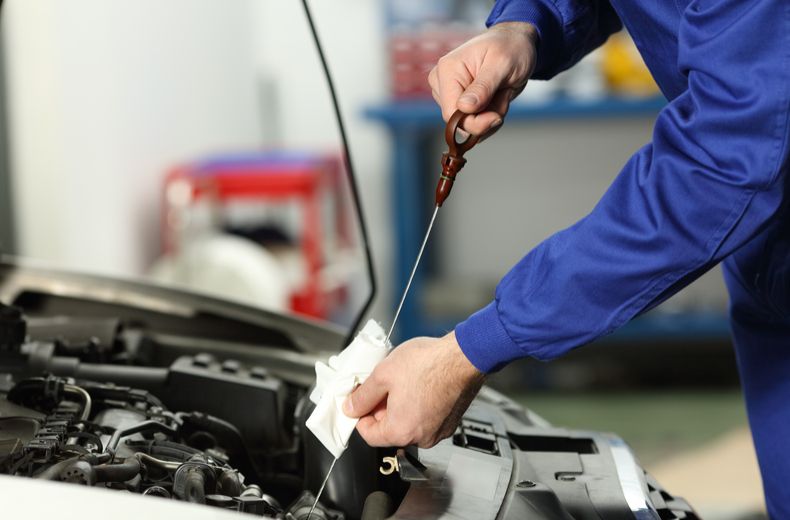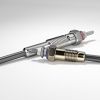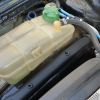Checking your fluid levels is one of the simplest yet most important bits of car maintenance you can do to help you avoid a breakdown.
Many motorists think it's not necessary if they follow their car's servicing schedule - but this isn't the case. Older engines in particular can develop oil leaks that you may not notice at first, while it's not unheard of for even modern engines to burn some oil during use.
You should get into the routine of checking your oil once every few weeks. Many modern cars will give you a warning message when your oil is low, but not all cars do this - and there's no absolute guarantee it'll work.
To help keep your fluid levels healthy, and your car on the road, we’ve put together our quick guide on how to check your engine oil.
Are you struggling with car maintenance? Contact your local RAC mobile mechanic.
How do I check engine oil?
When checking your engine oil, follow these simple steps:
Ensure your vehicle’s parked on level ground - uneven ground will give you an incorrect oil level reading. Ideally your engine should be cool.
Open your bonnet and locate the dipstick. If you’re unsure where this is, check your user manual. Your car may not have a dipstick – some modern cars are fitted with electronic oil monitors.
Once you’ve found the dipstick, pull it out and wipe off all the oil with a cloth or rag. You should notice two marks on the dipstick itself, identifying the minimum and maximum oil levels.
When it’s clean, put the dipstick back into its tube, pushing it all the way back in. Let it sit and then remove it again.
If the level is halfway between the minimum and maximum levels on the dipstick you don’t need to add any oil. If it’s below halfway, you may want to add some oil. If it’s below the minimum mark, you need to add oil.
If you do need to top up, make sure you have the correct oil for your car and locate the oil cap on your engine – usually marked with the picture of an oil can. If you are unsure which oil to use, check your vehicle owner's manual.
Remove the cap and pour in the oil a little at a time, checking the level with the dipstick to ensure you don’t pour in too much, as this can also cause damage.
Replace the cap and the dipstick and clear up any oil spills before closing the bonnet.

RAC sale – up to 33% off*
• Roadside cover from £5.29 a month†
• We get to most breakdowns in 60 mins or less
• Our patrols fix 4/5 breakdowns on the spot

What should my engine oil level be?
There is no set amount of oil that every car needs – it depends on the type and size of your engine. However, the dipstick in your car’s engine will clearly indicate what your engine’s oil level should be. If in doubt check the owner's manual.
Some car brands stipulate that you top up your car's oil with a specific grade designed for that engine. Sometimes this oil can only be purchased through the carmaker itself. Ensure to use the correct grade - if your car is under warranty, not using the correct oil could invalidate it.
What colour should my engine oil be?
When you buy a new bottle of oil, it will be a clear, golden colour that makes it look a lot like syrup (although you wouldn’t want to pour this onto your pancakes).
When it’s in an engine, the oil will quickly change into a dark brown colour which may seem quite alarming. This is perfectly normal and doesn’t mean there’s anything wrong with your engine - it's because the oil is repeatedly heated up and cooled during use.
When should I check my oil level?
Manufacturers usually recommend changing your oil either after 12 months or a set mileage point, whichever comes sooner. Some cars can go for two years without an oil change. Be sure to check your car's service intervals - modern cars often warn you when it is time for a service.
You should still check your engine oil at regular intervals to ensure your car remains safe to drive.
You should ideally check your engine when it's cold, but a warm engine is fine. Wait at least 10 minutes after use before checking to ensure you get an accurate reading and don’t accidentally burn yourself on a hot engine.
Which is the best oil for my car?
Again, this depends on your vehicle but you need to make sure you use the correct oil for your car.
The oil grade indicates how thick or thin the oil needs to be to work with your engine. Thinner oils flow faster than thicker oils, and the engine has been specifically designed to work with a certain grade.
To find out what oil your car needs, check your handbook or contact the manufacturer, as it’s essential you use one that meets its technical specifications.
Once you’ve identified the correct oil, check out the range of lubricants and oils available at the RAC Shop.
Keep your engine running smoothly
The RAC recommends regular oil changes help keep your engine running smoothly and extend its life. Book an RAC Mobile Mechanic today.


Where should I check my oil level?
Checking your oil levels is a quick and easy process that can be done easily while your car is parked in your driveway or outside your home.
If you have a problem with your oil, or if you have any other issues with your vehicle, contact one of the RAC’s Approved Garages and book your car in to see a professional at a garage you can trust.
Why should I check my engine oil level?
The oil in your engine is one of your vehicle’s most important elements. It keeps all the engine’s internal parts moving as they should, and stops them from wearing out too quickly.
If the oil level in your engine drops too low, then the lubrication of the engine's moving parts won't be sufficient. This means they can rub together, causing increased friction, excess heat and wear of the engine components.
Eventually this can lead to significant, irreversible engine damage, overheating and even fires.
Oil should be drained and refilled annually as part of the servicing schedule. But that doesn’t mean you shouldn’t still check your levels at regular intervals throughout the year to avoid your engine running low.
Get complete breakdown cover today with the RAC, or check out our approved garages for servicing. Or we can come to you with an RAC Mobile Mechanic.
Get a service or repair at home
RAC Mobile Mechanics can come to you, saving you the hassle of going to a garage.


How to check your oil - FAQ
- How do I know the correct oil for my car?
The best place to check you have the right oil for your car, is by checking the car’s owners manual. You should make sure to choose the right oil viscosity, which is a measure of the oil’s thickness. You should also make sure to use oil with the correct additives. Many cars require synthetic oil, which is designed to last longer and perform better than conventional oil.
- How do I add oil to my car?
Here are the steps you should take when adding oil to your car:
1. Locate the oil dipstick. This is usually located near the front of the engine, near the radiator. Make sure the car is parked on a level surface and the engine is off.
2. Pull the dipstick out. Wipe the end of the dipstick clean with a rag, then re-insert it into the engine. Pull it out again and check the level of the oil.
3. If the oil level is low, add oil. Find the oil filler cap, which is usually located near the top of the engine. Remove the cap and pour in the correct type and amount of oil, as specified by your vehicle’s owner’s manual.
4. Replace the oil filler cap. After you’ve added the oil, make sure the cap is securely replaced and tightened.
5. Check for any leaks. Have a look around the engine to make sure there are no oil leaks. - What are the 3 types of oil for cars?
There are three main types of oil for cars. The first type of oil for cars is conventional oil. This oil is made from petroleum-based products, and it is the most widely used type of oil. It is designed to provide basic lubrication for an engine and to help protect it from wear and tear. Conventional oil is also relatively inexpensive, making it a popular choice for drivers on a budget.
The second type of oil is synthetic oil. This oil is made from synthetic materials and is designed to provide superior protection for an engine. It is more expensive than conventional oil, but it offers better lubrication and can help increase engine performance. It is recommended for high-performance engines and vehicles that are driven in extreme conditions.
The third type of oil is synthetic blend oil. This oil is a combination of conventional and synthetic oils and is intended to provide the best of both worlds. It is more expensive than conventional oil, but it can provide both the protection of synthetic oil and the affordability of conventional oil. - How do I check my engine oil?
Here’s how you can check your engine oil:
1. Park your car on a level surface and turn off the engine. Make sure the car is completely cool before checking the engine oil.
2. Locate the oil dipstick. This is usually in the engine bay and marked with an “oil” label. Pull the dipstick out and wipe it clean with a cloth.
3. Reinsert the dipstick and wait a few seconds before pulling it out again. The dipstick should have a line that measures the amount of oil in the engine.
4. Check the oil level. If it’s below the “low” mark, you’ll need to add more oil. If it’s above the “full” mark, you may have too much oil and should drain some out.
5. Check the oil’s color and consistency. It should be a light brown color with a slightly viscous texture. If it’s black and thick, you may need to change your engine oil.
6. Reinsert the dipstick and close the hood.7. Check for leaks, and then turn on the engine. You may get an engine warning light if there is a wider issue.
- Can I use any 5W-30 oil in my car?
5W-30 is a multi-viscosity oil that is commonly used in modern vehicles. 5W-30 oil is thinner when cold and thicker when hot, providing better protection in a variety of temperatures. But this doesn’t mean you can use any 5W-30 oil. Check your car owner’s guide or search for your make and model online to see if it is correct. By taking the time to do your research, you can make sure you’re using the best oil for your car.
- How much engine oil should I put in my car?
When it comes to adding engine oil to your car, the amount you need to add depends on the type of car you have and the type of oil you are using. The best way to determine the amount of oil you need to add to your car is to check your owner’s manual. The manual will provide you with the exact amount of oil your car requires and the type of oil it should be using.
- When should you check engine oil?
Generally, you should check your engine oil every 3,000 miles or 3 months, whichever comes first. It’s important to check your oil when the engine is cold, as this will give you an accurate reading. Before you check the oil, make sure your car is parked on level ground. If the oil is low, add oil as necessary. If the oil level is too high, you may need to have the oil drained and refilled.
- How do I know if my car engine oil is low?
If your engine oil is low, it can cause serious damage to your engine and can even lead to expensive repairs. Here are some steps to help you determine if your car engine oil is low:
1. Check your car’s oil level with the dipstick. Open the hood of your car and remove the dipstick from the engine. Wipe the dipstick clean with a rag, reinsert it into the engine and remove it again. The oil should reach the “full” line on the dipstick. If it does not, you will need to add oil.
2. Look for signs of oil leaks. If you see any oil stains underneath your car, it could be a sign that your oil is low.
3. Listen for excessive engine noise. If you hear an unusual noise coming from your engine, it could indicate that your engine oil is low.
4. Monitor your car’s performance. If you notice your car is running rougher than usual, it could be a sign that your engine oil is low.
If you determine that your engine oil is low, be sure to add more oil to the engine as soon as possible. Failing to do so can cause serious damage to your engine and can lead to an expensive repair. - Which oil is thicker 5W-30 or 10w30?
When it comes to choosing between 5W-30 and 10w30, it’s important to note that each type of oil has its own benefits and drawbacks. 5W-30 is thinner and more easily flows through the engine, but it may not provide as much protection as 10w30. 10w30 is thicker and provides better protection, but it may cause more friction and wear on the engine. Ultimately, the best oil for your vehicle is the one recommended by the manufacturer.
- Do you put oil in the car when it's on or off?
Most conventional motor oils should be added when the engine is off and cold. This allows the oil to properly circulate through the engine. However, there are some synthetic oils that are designed to be added when the engine is running. It is generally best to refer to the manufacturer’s instructions for your specific make and model before adding oil to ensure you are using the correct type of oil and adding it correctly.













